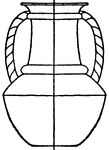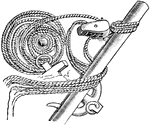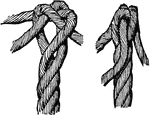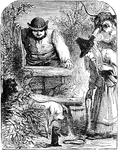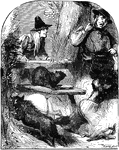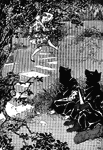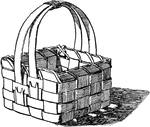
Basket made of wood shavings
"Pine shavings are the best to use, as they are less brittle than those of harder woods. Select a number…

Blackwall Hitch
To tie a blackwall hitch, form a bight at the end of a rope, and put the hook of a tackle through the…

Two Egyptian Boats
"Two boats moored to the bank of the river by ropes and stakes. In the cabin of one, a man inflicts…

Capstan
"The capstan is a familiar example of this form of wheel and axle. It is used by sailors for warping…

Carrick Bend
To tie a carrick bend, lay the end of one rope over its own standing part so as to form a bight. Put…

Clove Hitch
To tie a clove hitch, first pass the end 'a' around a spar, and cross it over 'b'. Pass it around the…

Jesus Carries His Cross and Comforts the Women Following Him
"And there followed him a great multitude of the people, and of women who bewailed and lamented him.…

Deadeye
A round, laterally flattened wooden block, encircled by a rope or an iron band, and pierced with three…

Deadeye
A round, laterally flattened wooden block, encircled by a rope or an iron band, and pierced with three…
Dummy
"Good judgement of distance is essential. Accuracy in thrusting and lunging is best attained by practicing…
Dummy
"dummies should be constructed in such a manner as to permit the execution of attacks wthout injury…
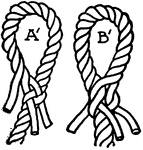
Eye-splice
"For making an eye splice, the end of the rope is unlaid and the strands are bent upon the body of the…
Fair-Leader
"Naut.: A strip of board with holes in it for running rigging to pass through and be kept clear, so…

Mast Fid
"Naut.: A square bar of wood or iron, with a shoulder at one end, used to support a topmast or topgallantmast…
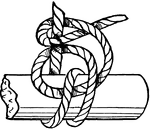
Fisherman's Bend
To tie a fisherman's bend, take two turns round a spar, then a half hitch round the standing part, and…

Flea Tight-Rope
An illustration of a flea dressed in a uniform walking across a tight rope while holding a stick.

Nautical Garland
"Garland lashed on a lower mast. A large rope strap or grommet lashed to a spar when hoisting it on…
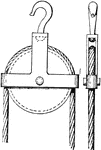
Gin-Block
"GIN-BLOCK. A simple form of tackle-block with a single wheel, over which a rope runs. It has a hook…
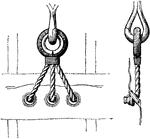
Glut
"Glut. Naut.: (b) A becket or thimble fixed on the after side of a topsail or course, near the head,…
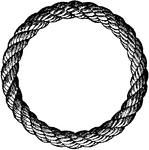
Grommet
"Grommet. Naut., a ring of rope used for various purposes, made from a strand laid three times round…

Egyptian Kitchen
"Scene in Egyptian kitchen, showing use of a large rope to support a sort of hanging shelf." -Hill,…

Bowline Knot
To tie a bowline knot, lay the end of the rope 'a' over 'b' so as to form a bight 'c'; pass the end…

Half-Hitch Knot
To form a half-hitch, pass the end 'a' of the rope around the standing part 'b', and through the bight.

Overhand Knot
The most common type of knot, the overhand is made by passing one end of a line over the line and around…

Square Knot
"This is much better than the granny knot, because it is easily untied, but will not loosen of itself."…

Knots and Splices
"Knots and splices include all the various methods of tying, fastening, and joining ropes or cords.…
Knots and Splices
"Knots and splices include all the various methods of tying, fastening, and joining ropes or cords.…
Knots and Splices
"Knots and splices include all the various methods of tying, fastening, and joining ropes or cords.…
Knots and Splices
"Knots and splices include all the various methods of tying, fastening, and joining ropes or cords.…

Knots and Splices
"Knots and splices include all the various methods of tying, fastening, and joining ropes or cords.…

Knots and Splices
"Knots and splices include all the various methods of tying, fastening, and joining ropes or cords.…
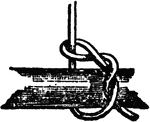
Knots and Splices
"Knots and splices include all the various methods of tying, fastening, and joining ropes or cords.…
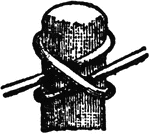
Knots and Splices
"Knots and splices include all the various methods of tying, fastening, and joining ropes or cords.…

Knots and Splices
"Knots and splices include all the various methods of tying, fastening, and joining ropes or cords.…
Knots and Splices
"Knots and splices include all the various methods of tying, fastening, and joining ropes or cords.…
Knots and Splices
"Knots and splices include all the various methods of tying, fastening, and joining ropes or cords.…
Knots and Splices
"Knots and splices include all the various methods of tying, fastening, and joining ropes or cords.…

Knots and Splices
"Knots and splices include all the various methods of tying, fastening, and joining ropes or cords.…
Knots and Splices
"Knots and splices include all the various methods of tying, fastening, and joining ropes or cords.…
Knots and Splices
"Knots and splices include all the various methods of tying, fastening, and joining ropes or cords.…

Knots and Splices
"Knots and splices include all the various methods of tying, fastening, and joining ropes or cords.…

Knots and Splices
"Knots and splices include all the various methods of tying, fastening, and joining ropes or cords.…

Knots and Splices
"Knots and splices include all the various methods of tying, fastening, and joining ropes or cords.…

Knots and Splices
"Knots and splices include all the various methods of tying, fastening, and joining ropes or cords.…

Knots and Splices
"Knots and splices include all the various methods of tying, fastening, and joining ropes or cords.…
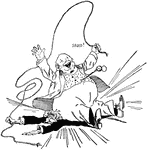
Overweight Man Sitting on a Smaller Man
A cartoon of an overweight man sitting on top of a smaller man, while holding a rope.

Peter Crucified on an Upside Down Cross
Illustration of Peter being bound to an upside down cross. One man holds his upper body, while another…
